|
Effective Teaching...
by Harry and Rosemary Wong |
|
To print: Select File and then Print from your browser's menu
------------------------------------------------------------------
This article was printed from Teachers.Net Gazette,
located at https://teachers.net.
------------------------------------------------------------------ |
Love, Marriage, and Babies, Oh My!
 It’s most unfortunate that 16 percent of new teachers and up to 50 percent of these same teachers will drop out of teaching by their fifth year in education. If only someone had taught them how to manage a classroom, they would be a flying success today.
It’s most unfortunate that 16 percent of new teachers and up to 50 percent of these same teachers will drop out of teaching by their fifth year in education. If only someone had taught them how to manage a classroom, they would be a flying success today.
 |
This is the story of two, successful, new teachers who will be in the profession for a long, long time. |
Cristina Bianchi
Cristina Bianchi was on maternity leave January/February of the 2014–2015 school year. The classroom procedures had been taught at the start of the school year, and she left the substitute teacher a manual on how the class was organized with procedures. She kept in contact by email and text with the sub during her time away from the classroom.
When Cristina returned, she simply had the class practice some of the procedures to reestablish them, and the class sailed along as if she had never been away. She says, “Middle schoolers don’t like surprises. I find that transparency works best with them.”
She acknowledges that her first years of teaching were successful because she spent time building a solid, classroom foundation with an organized structure.
She identifies the two items that created the solid, classroom structure:
- Having proper classroom management and procedures
- Having the knowledge and skills to use the curriculum to meet the student’s instructional needs
Consistency in Cristina’s First Five Minutes
The structure she built created a culture of consistency where the students all knew what was happening each day—no matter who was leading the class.
Each day, I greet my students at the door as they are walking into the room. I have found that this is the best time for me to address their non-classroom-related concerns, rather than it being done during instructional time.
Upon entering the classroom, the students read our Do Now Board, which always has our daily task and any materials they may need to pick up at the front work bench. They also complete their task and/or lab notebook and take out all supplies needed for class—lab notebook, writing utensil, homework, etc. During this time, I am taking attendance.
Everything in the classroom has a procedure and the students know how to carry out our daily tasks within the first five minutes. Having a consistent, orderly system and procedures in place has really helped my students to focus on learning for the day!
We met Cristina Bianchi when she was one of the teachers in the room at our Providence School District New Teacher Induction Program presentation. We spoke on classroom management and teaching for mastery. Shortly after the school year began, she sent pictures of her classroom.
You can see why she is successful.
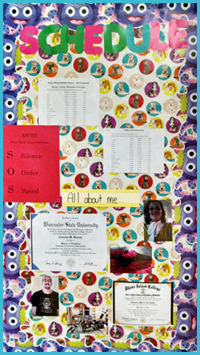 Connection – Cristina establishes a connection with her students with an “All About Me” classroom display.
Connection – Cristina establishes a connection with her students with an “All About Me” classroom display.
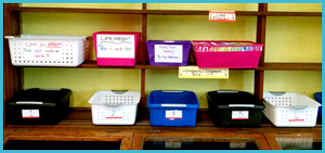 Preparation – Cristina is prepared and organized and teaches her students to be organized in their work, too.
Preparation – Cristina is prepared and organized and teaches her students to be organized in their work, too.
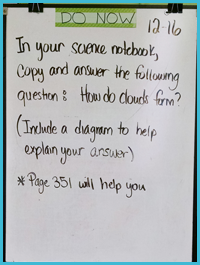 Do Now – There is a Do Now assignment ready for the students before they enter the classroom. Before the end of the first five minutes of class, the students are doing the Do Now work.
Do Now – There is a Do Now assignment ready for the students before they enter the classroom. Before the end of the first five minutes of class, the students are doing the Do Now work.
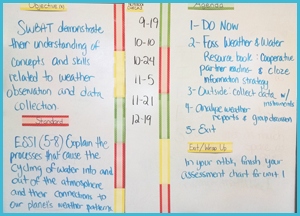 Daily Agenda – There is an Agenda posted daily to let students see the learning for the class period and what activities they will be doing that day to learn the lesson objectives.
Daily Agenda – There is an Agenda posted daily to let students see the learning for the class period and what activities they will be doing that day to learn the lesson objectives.
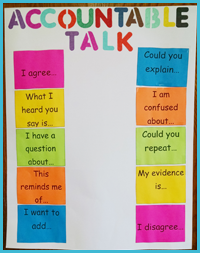 Accountable Talk – Having a system for organized talk minimizes the discourteous replies and comments in a classroom. Cristina teaches the procedure of Accountable Talk. With Accountable Talk, every student has a voice. Reflection on the lesson and sharing their understanding of the lesson is a critical part of learning. Accountable Talk teaches students courtesy and cuts down on inappropriate comments to peers.
Accountable Talk – Having a system for organized talk minimizes the discourteous replies and comments in a classroom. Cristina teaches the procedure of Accountable Talk. With Accountable Talk, every student has a voice. Reflection on the lesson and sharing their understanding of the lesson is a critical part of learning. Accountable Talk teaches students courtesy and cuts down on inappropriate comments to peers.
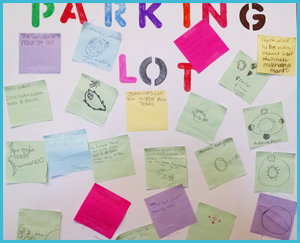 Parking Lot – Students create an Exit Ticket and leave them in the Parking Lot as they leave the classroom for the day. The sticky note allows students to reflect on their own learning. Cristina uses them to assess for student learning and student progress. The tickets tell her what she needs to review, what went well, and where to begin the lesson for the next day. The assessment provides a springboard for the next time the class is together.
Parking Lot – Students create an Exit Ticket and leave them in the Parking Lot as they leave the classroom for the day. The sticky note allows students to reflect on their own learning. Cristina uses them to assess for student learning and student progress. The tickets tell her what she needs to review, what went well, and where to begin the lesson for the next day. The assessment provides a springboard for the next time the class is together.
Schoolwide Consistency
RACES and TILES are schoolwide acronyms used to guide students to reach the writing and graphing goals for all of the science classes at her school.
RACES for writing science goals:
R - Restate the question in a different way.
A - Answer the question clearly and completely.
C - Cite your source. Where did your information come from?
E - Elaborate; give evidence and examples.
S - Summarize your work.
TILES for graphing science goals:
T - Title is meaningful and descriptive.
I - Interval is accurate and without gaps.
L - Label is on both axes.
E - Evidence is depicted.
S - Scale is used.
Before either type of assignment is given, Cristina reviews the steps in the acronym. This helps students remember how to keep their work methodical and organized. She says, “Having goals for learning is important, but it’s even more important that the students see you are reinforcing and supporting the school goals through your classroom assignments.”
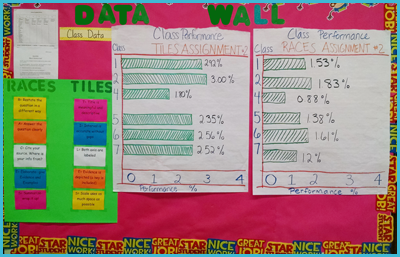 Class Performance – The RACES and TILES goals are displayed as Class Performance data for scoring and grading purposes as well as monitoring progress.
Class Performance – The RACES and TILES goals are displayed as Class Performance data for scoring and grading purposes as well as monitoring progress.
This poster shows each of Cristina’s science classes’ performances for a given assignment on a scale of 0-4.
All formative assignments given in class support the students’ progress by working on similar skills. The expectation is that students make progress from one summative assignment to the next.
A rubric is used with both types of assignments and is reviewed with the students. The rubric is on a 0–4 point scale, and each point earned is specifically linked to each indicator that they’re being assessed on. Cristina explains the rubric. Then performance is reviewed by students individually and by the teacher as a whole group. Student data folders are maintained, and the students complete their own assessment of their work. This practice makes them aware of their own strengths and weaknesses.
 Just as Cristina’s class progressed during her maternity leave, they progress each day as they improve in their own learning and achievement. Cristina’s well-managed classroom gives her the opportunity to devote her time to student learning and achievement, by day, and by night, to devote her time to her beautiful new family.
Just as Cristina’s class progressed during her maternity leave, they progress each day as they improve in their own learning and achievement. Cristina’s well-managed classroom gives her the opportunity to devote her time to student learning and achievement, by day, and by night, to devote her time to her beautiful new family.
Janelle Papazian
Our best wishes to Janelle Papazian, a brand-new teacher who was married last month. Besides marrying a fantastic partner for life, her good fortune also finds her in the Roosevelt School District in Phoenix, Arizona. The district has a comprehensive, new teacher induction program in their Educator Effectiveness Department. The focus of the Educator Effectiveness Department is to produce effective teachers.
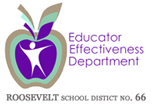
Earlier this year, we wrote in detail about other school districts and their induction programs. Please see the February, March, and April columns to learn more about developing new teachers.
Dreams Do Come True
Janelle dreamed of being a teacher since she was nine years old. She would skip recess and stay inside to help teachers with anything they needed. When she graduated from college, she wrote to four of her teachers and thanked them for inspiring her. She told them she was now a first-grade teacher, and her mission was to inspire her students.
Janelle says, “I believe that with my procedures, organization, 12-hour days, tears, and high expectations, it made my first year of teaching incredible. My procedures were in place so there were no questions. I set high expectations for these seven-year-olds, and they rose to the challenge, giving me enough stories I could write a book. I went over the procedures every day for my first week and then posted them. I also sent them home to their parents so they knew what type of environment their children were in every day.”
Janelle is very organized and has taken photos of her classroom to give you a guided tour of the culture of consistency she has established for her students and herself. Click here to visit her classroom.
Consistency in Janelle’s First Five Minutes
When the school year began, Janelle immediately put the classroom organization in place.
When the bell rings, I stand at the door greeting my students. I say, "Good morning," to each of my students, including the child’s name in the greeting. As students walk in, there is Disney music playing, and the procedures are posted on the board stating these tasks:
- Unpack and turn in work
- Sharpen pencils
- Get breakfast
- Start morning work
During this time I am documenting attendance and lunch count.
I also watch student behavior. If I see someone looking sad, I make sure I approach the student and say good morning again and ask if everything is okay.
We then listen to announcements.
I have used this opening procedure since Day One of my teaching experience, and it has worked great for my first graders.
Is it any wonder that Janelle says, “My students love their classroom. They are responsible, and I already have second-grade teachers telling me they want my students. I take pride in my students, my accomplishments, and most of all, I take pride in the fact I was told this time last year I would never become a teacher, and that I was not going to graduate college.”
“Now one year later, I am getting compliments from my
administration, parents, and students.”

The Roosevelt School District’s Educator Effectiveness Department saw the potential in Janelle and nurtured and trained her with its induction program. Janelle is destined to live happily ever after in and out of the classroom.
Reality TV
Our nightly television viewing (five hours on average according to a recent poll) is heavily peppered with reality TV shows. From “Survivor” to “Amazing Race,” these shows bring unknowns into the forefront of unscripted, real-life situations and make them stars.
The reality is these shows are not as unscripted as one might think. Very few of the shows are shown live as the action happens. This gives the producers and directors time to edit the content to create the perfect television event.
Your classroom is the ultimate reality show. It airs hundreds of thousands of times, 180 days of the year. There is no producer yelling, “Cut!” There is no director saying, “Take a deep breath and exhale before you say that line.”
You are the Producer, Director, and Star of your classroom. You have the capacity to create the number one classroom of all time. You have the potential to become the teacher all teachers measure themselves up against. You have power to set the trend for what should happen every day in classrooms around the world.
Become the Superstar you were meant to be and walk that red carpet every day you cross the threshold of your classroom.
Harry & Rosemary Wong products: http://EffectiveTeaching.com
This printable version is provided for the convenience of individuals.
 It’s most unfortunate that 16 percent of new teachers and up to 50 percent of these same teachers will drop out of teaching by their fifth year in education. If only someone had taught them how to manage a classroom, they would be a flying success today.
It’s most unfortunate that 16 percent of new teachers and up to 50 percent of these same teachers will drop out of teaching by their fifth year in education. If only someone had taught them how to manage a classroom, they would be a flying success today.
 Connection – Cristina establishes a connection with her students with an “All About Me” classroom display.
Connection – Cristina establishes a connection with her students with an “All About Me” classroom display.  Preparation – Cristina is prepared and organized and teaches her students to be organized in their work, too.
Preparation – Cristina is prepared and organized and teaches her students to be organized in their work, too.  Do Now – There is a Do Now assignment ready for the students before they enter the classroom. Before the end of the first five minutes of class, the students are doing the Do Now work.
Do Now – There is a Do Now assignment ready for the students before they enter the classroom. Before the end of the first five minutes of class, the students are doing the Do Now work.  Daily Agenda – There is an Agenda posted daily to let students see the learning for the class period and what activities they will be doing that day to learn the lesson objectives.
Daily Agenda – There is an Agenda posted daily to let students see the learning for the class period and what activities they will be doing that day to learn the lesson objectives.  Accountable Talk – Having a system for organized talk minimizes the discourteous replies and comments in a classroom. Cristina teaches the procedure of Accountable Talk. With Accountable Talk, every student has a voice. Reflection on the lesson and sharing their understanding of the lesson is a critical part of learning. Accountable Talk teaches students courtesy and cuts down on inappropriate comments to peers.
Accountable Talk – Having a system for organized talk minimizes the discourteous replies and comments in a classroom. Cristina teaches the procedure of Accountable Talk. With Accountable Talk, every student has a voice. Reflection on the lesson and sharing their understanding of the lesson is a critical part of learning. Accountable Talk teaches students courtesy and cuts down on inappropriate comments to peers.  Parking Lot – Students create an Exit Ticket and leave them in the Parking Lot as they leave the classroom for the day. The sticky note allows students to reflect on their own learning. Cristina uses them to assess for student learning and student progress. The tickets tell her what she needs to review, what went well, and where to begin the lesson for the next day. The assessment provides a springboard for the next time the class is together.
Parking Lot – Students create an Exit Ticket and leave them in the Parking Lot as they leave the classroom for the day. The sticky note allows students to reflect on their own learning. Cristina uses them to assess for student learning and student progress. The tickets tell her what she needs to review, what went well, and where to begin the lesson for the next day. The assessment provides a springboard for the next time the class is together.  Class Performance – The RACES and TILES goals are displayed as Class Performance data for scoring and grading purposes as well as monitoring progress.
Class Performance – The RACES and TILES goals are displayed as Class Performance data for scoring and grading purposes as well as monitoring progress.  Just as Cristina’s class progressed during her maternity leave, they progress each day as they improve in their own learning and achievement. Cristina’s well-managed classroom gives her the opportunity to devote her time to student learning and achievement, by day, and by night, to devote her time to her beautiful new family.
Just as Cristina’s class progressed during her maternity leave, they progress each day as they improve in their own learning and achievement. Cristina’s well-managed classroom gives her the opportunity to devote her time to student learning and achievement, by day, and by night, to devote her time to her beautiful new family.
